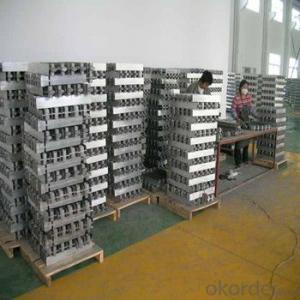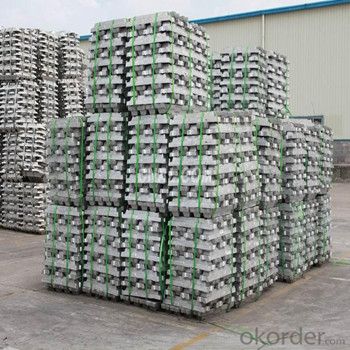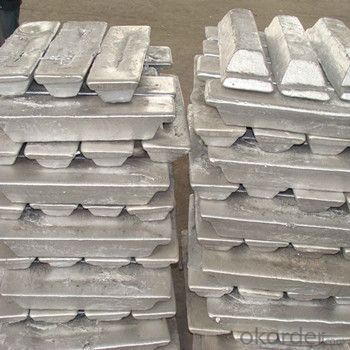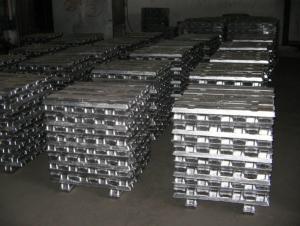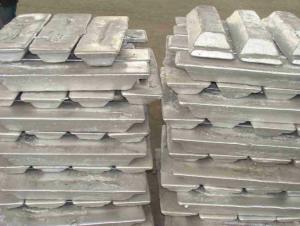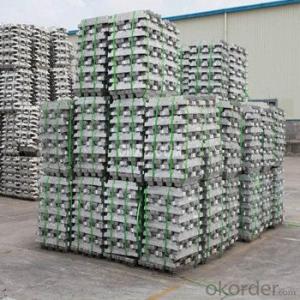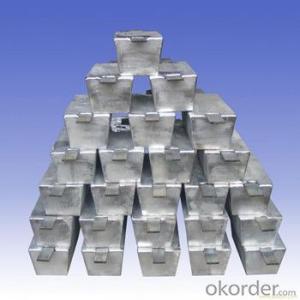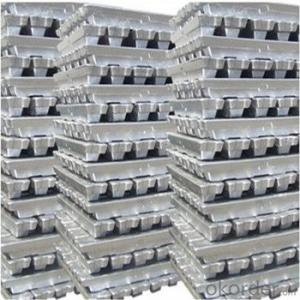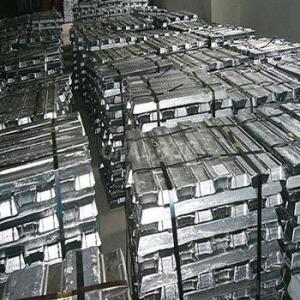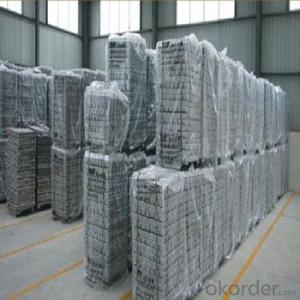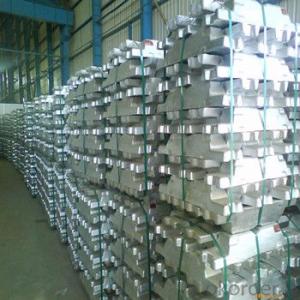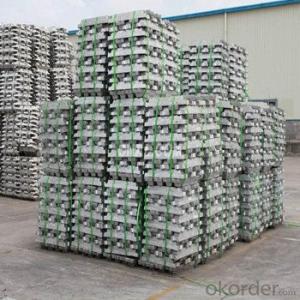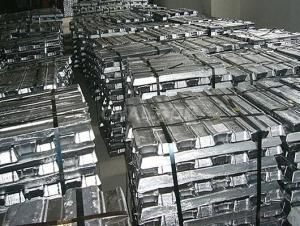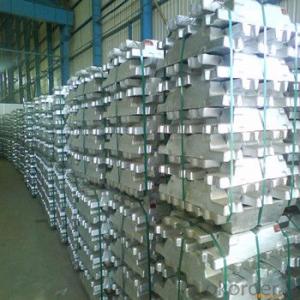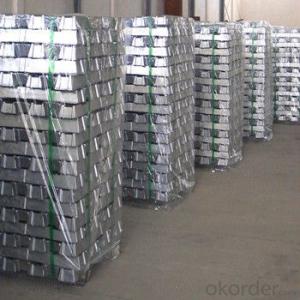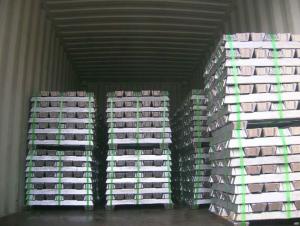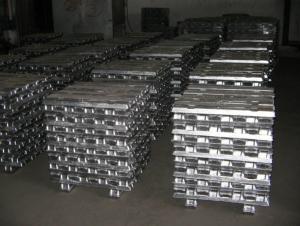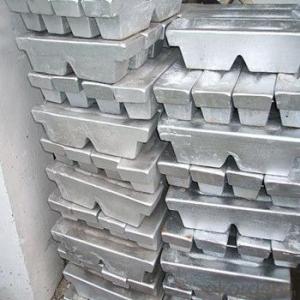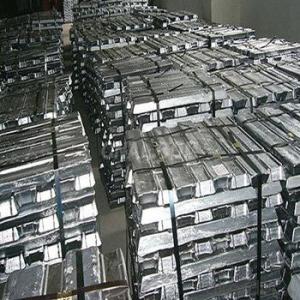Aluminium Ingots 99.7% 2015 Popular Best -Seller
- Loading Port:
- China main port
- Payment Terms:
- TT OR LC
- Min Order Qty:
- 1000 m.t.
- Supply Capability:
- 10000 m.t./month
OKorder Service Pledge
OKorder Financial Service
You Might Also Like
Pure Aluminum Ingot Used for Industry
1.Structure of Aluminum Ingot Description
Aluminum ingot for remelting is produced by molten salt electrolysis method using alumina and cryolite. Products meet the national standard GB/T1196-2002. The surface of ingot is clean and smooth. An ingot is a piece of material, usually metal, that is cast into a shape suitable for further processing. Insteelmaking, it is the first step among semi-finished casting products. Ingots usually require a second procedure of shaping, such as cold/hot working, cutting, or milling to produce a useful final product.
2.Main Features of the Aluminum Ingot
•High Purity
•High strength
•Fast melting
•Best price
•Good after-service
3. Aluminum Ingot Images
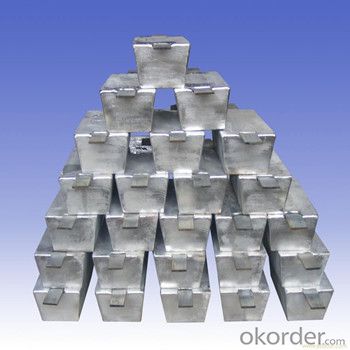
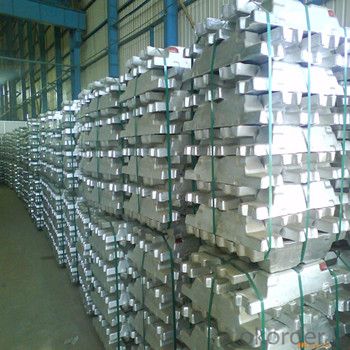
4. Aluminum Ingot Specification
Grade | Chemical Composition % | |||||||||
Al≥ | impurities ≤ | |||||||||
Si | Fe | Cu | Ga | Mg | Zn | Mn | others | Sum | ||
Al99.9 | 99.90 | 0.50 | 0.07 | 0.005 | 0.02 | 0.01 | 0.025 | - | 0.010 | 0.10 |
Al99.85 | 99.85 | 0.80 | 0.12 | 0.005 | 0.03 | 0.02 | 0.030 | - | 0.015 | 0.15 |
Al99.7 | 99.70 | 0.10 | 0.20 | 0.010 | 0.03 | 0.02 | 0.030 | - | 0.030 | 0.30 |
Al99.6 | 99.60 | 0.16 | 0.25 | 0.010 | 0.03 | 0.03 | 0.030 | - | 0.030 | 0.40 |
Al99.5 | 99.50 | 0.22 | 0.30 | 0.020 | 0.03 | 0.05 | 0.050 | - | 0.030 | 0.50 |
Al99.00 | 99.00 | 0.42 | 0.50 | 0.020 | 0.03 | 0.05 | 0.050 | - | 0.050 | 1.00 |
5.FAQ of Aluminum Ingot
We have organized several common questions for our clients,may help you sincerely:
①How about your company?
A world class manufacturer & supplier of castings forging in carbon steel and alloy steel,is one of the large-scale professional investment casting production bases in China,consisting of both casting foundry forging and machining factory. Annually more than 8000 tons Precision casting and forging parts are exported to markets in Europe,America and Japan. OEM casting and forging service available according to customer’s requirements.
②How to guarantee the quality of the products?
We have established the international advanced quality management system,every link from raw material to final product we have strict quality test;We resolutely put an end to unqualified products flowing into the market. At the same time, we will provide necessary follow-up service assurance.
③How long can we receive the product after purchase?
In the purchase of product within three working days, We will arrange the factory delivery as soon as possible. The pecific time of receiving is related to the state and position of customers.Commonly 7 to 10 working days can be served.
- Q: How is aluminium powder made into aluminium ingot?
- If it is pure aluminum powder, then it needs smelting forming
- Q: How many tons of alumina for a ton of aluminum ingot, alumina and electrolytic aluminum what is the difference?
- Electrolytic aluminum is a metallic aluminum refined by electrolysis. It is an aluminum of high purity.
- Q: What industries use aluminum ingots?
- Several industries use aluminum ingots due to their versatile properties and wide range of applications. Some of the major industries that extensively rely on aluminum ingots include: 1. Automotive Industry: Aluminum ingots are used in the manufacturing of various automotive components such as engine blocks, wheels, frames, and body panels. Aluminum's lightweight nature, corrosion resistance, and excellent thermal conductivity make it a preferred choice for enhancing fuel efficiency and reducing vehicle weight. 2. Aerospace Industry: Aluminum ingots find extensive use in the aerospace industry for manufacturing aircraft structures, wings, fuselage panels, and other components. Aluminum's high strength-to-weight ratio makes it ideal for building lightweight aircraft that can withstand the stresses and strains of flight. 3. Construction Industry: The construction sector utilizes aluminum ingots for various applications such as windows, doors, roofing, and cladding systems. Aluminum's corrosion resistance, durability, and aesthetic appeal make it a popular choice for modern architectural designs. 4. Packaging Industry: Aluminum ingots are widely used in the packaging industry to produce aluminum foils, cans, containers, and closures. Aluminum's excellent barrier properties, lightness, and recyclability make it a preferred material for preserving and protecting food, beverages, pharmaceuticals, and other perishable items. 5. Electrical Industry: Aluminum ingots are extensively used in the electrical industry for manufacturing power transmission cables, electrical conductors, and wiring systems. Aluminum's high electrical conductivity, low weight, and cost-effectiveness make it a suitable alternative to copper in many electrical applications. 6. Marine Industry: Aluminum ingots are employed in the marine industry for fabricating boat hulls, masts, decks, and various other components. Aluminum's corrosion resistance, lightness, and durability make it a preferred choice for constructing vessels that can withstand harsh marine environments. 7. Consumer Goods Industry: Aluminum ingots are utilized in the consumer goods industry for manufacturing a wide range of products such as cookware, furniture, appliances, and electronic devices. Aluminum's thermal conductivity, non-toxicity, and recyclability make it a popular material for consumer goods. These are just a few examples of the industries that heavily rely on aluminum ingots. Due to its numerous advantageous properties, aluminum is widely used in various other sectors such as machinery, transportation, energy, and even in art and design.
- Q: How are aluminum ingots used in the production of consumer goods?
- Aluminum ingots are widely used in the production of consumer goods due to their versatility and desirable properties. These ingots are first melted and then transformed into various forms, such as sheets, bars, or coils, to suit different manufacturing processes. One common application of aluminum ingots is in the production of packaging materials. Aluminum foils and cans are lightweight, corrosion-resistant, and malleable, making them ideal for preserving food and beverages. The ingots are rolled into thin sheets, which are then used to create these packaging materials. Another major usage of aluminum ingots is in the automotive industry. Aluminum's low density and high strength-to-weight ratio make it an excellent choice for manufacturing car parts, such as engine components, body panels, and wheels. By using aluminum ingots, automakers can produce lighter vehicles, resulting in improved fuel efficiency and better performance. Additionally, aluminum ingots find applications in the construction sector. The ingots are often extruded into profiles that are used for windows, doors, and curtain walls. Aluminum's corrosion resistance and ability to withstand extreme weather conditions make it a popular choice for such building materials. Furthermore, aluminum ingots are utilized in the production of consumer electronics. The lightweight nature of aluminum makes it an ideal material for manufacturing laptops, tablets, and smartphones, where the reduction of weight is crucial for portability. The ingots are processed into casings, frames, and other components for these electronic devices. Overall, aluminum ingots play a vital role in the production of a wide range of consumer goods. Their versatility, lightweight nature, and corrosion resistance make them ideal for various applications, including packaging, automotive, construction, and electronics industries.
- Q: What method does common smelting aluminium ingot adopt now?
- Only the electric stove, the stove is not expensive, the electricity price is relatively stable, melts one ton aluminum ingot, theoretically consumes 500 degrees, moreover the power consumption itself does not have the pollution, should be the first choice.
- Q: What does aluminium ingot blacken because of temperature? Rain? Aluminium oxide? Iron salt?
- Is the oxidation of alumina. The color is not necessarily to generate the first white alumina, then gray green, finally is black. Because there is water vapor. Laboratory control conditions, can certainly get white alumina. In reality are black.
- Q: What are the energy requirements for producing aluminum ingots?
- The energy requirements for producing aluminum ingots are significant, as the production process involves several stages that consume large amounts of electricity. The primary energy-intensive steps include mining and refining bauxite ore into alumina, which requires a substantial amount of electrical power. Additionally, the electrolytic reduction of alumina to aluminum in the smelting process demands a significant energy input. Overall, the production of aluminum ingots is an energy-intensive process that necessitates substantial electricity consumption.
- Q: What are the main factors influencing the choice between aluminum ingots and aluminum castings?
- The choice between aluminum ingots and aluminum castings is influenced by several factors. Firstly, the desired shape and complexity of the final product plays a crucial role. Aluminum ingots are typically used for simple shapes that require minimal machining or finishing. On the other hand, aluminum castings are preferred for more intricate designs and complex geometries as they offer greater flexibility in achieving the desired shape. Secondly, the required mechanical properties of the product also influence the choice. Aluminum ingots are commonly used when high strength and durability are essential. This is because ingots undergo a more controlled solidification process, leading to a more uniform and predictable material structure. Castings, however, may exhibit slight variations in material properties due to the casting process, making them more suitable for applications that prioritize design intricacy over mechanical strength. Cost is another significant factor. Aluminum ingots generally have a lower initial cost compared to aluminum castings. However, castings may offer cost advantages in terms of reduced material waste and lower energy consumption during production. Additionally, the casting process allows for the consolidation of multiple components into a single casting, potentially reducing assembly costs. The required volume of production is also a determining factor. Aluminum ingots are commonly used for mass production due to their ability to be easily extruded or rolled into various shapes. Castings, on the other hand, are more suitable for low to medium volume production runs, as the casting process requires the creation of molds and may involve more time and labor. Lastly, considerations such as environmental impact and sustainability may influence the choice between aluminum ingots and castings. While both options are recyclable, castings may offer a slight advantage as they typically require less energy for production and generate less material waste during the manufacturing process. Overall, the main factors influencing the choice between aluminum ingots and aluminum castings include the desired shape and complexity of the product, required mechanical properties, cost considerations, production volume, and environmental factors.
- Q: What are the scouring agents in the die casting process, such as slag remover, coating agent, flux, and what matters should be paid attention to when the aluminium ingot is dissolved?,
- scouring agentFor refining alloy liquid, the main purpose is to remove the gas inside the liquid metal liquid, raise the density of the aluminum liquid die-casting
- Q: What are the impurities found in aluminum ingots?
- Aluminum ingots, the primary raw material for various aluminum products, may contain several impurities that can be classified into metallic, non-metallic, and gas impurities. Metallic impurities found in aluminum ingots consist of elements like iron, silicon, copper, manganese, zinc, and magnesium. These impurities can originate from the raw materials or the equipment used during melting and casting. They have a negative impact on the quality and performance of the final aluminum products, affecting their strength, corrosion resistance, and other mechanical properties. Non-metallic impurities in aluminum ingots include compounds and particles such as oxides, carbides, nitrides, and sulfides. These impurities arise from the presence of oxygen, nitrogen, sulfur, or carbon during production. They can cause defects in aluminum products, like porosity, inclusions, or uneven microstructure, weakening the material and reducing its overall quality. Gas impurities are another type of impurity found in aluminum ingots. Common gases present in the ingots are hydrogen, oxygen, nitrogen, and carbon monoxide. These gases can enter during melting and casting or result from the molten aluminum interacting with the surrounding atmosphere. Gas impurities can lead to internal defects in aluminum products, such as gas porosity or bubbles, impairing their mechanical properties and appearance. To ensure the quality of aluminum ingots and resulting products, rigorous quality control measures are implemented throughout the production process. Techniques like refining, degassing, and filtration are used to minimize impurities in the ingots. Thorough testing and analysis are also conducted to monitor and verify impurity levels, ensuring compliance with industry standards and customer requirements.
Send your message to us
Aluminium Ingots 99.7% 2015 Popular Best -Seller
- Loading Port:
- China main port
- Payment Terms:
- TT OR LC
- Min Order Qty:
- 1000 m.t.
- Supply Capability:
- 10000 m.t./month
OKorder Service Pledge
OKorder Financial Service
Similar products
Hot products
Hot Searches
Related keywords
